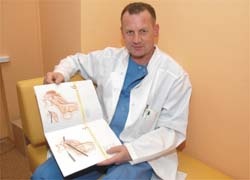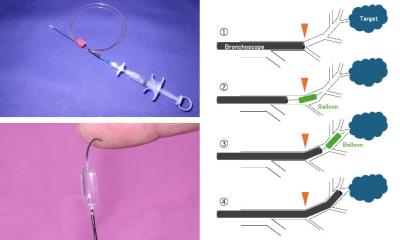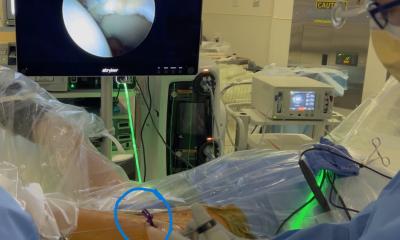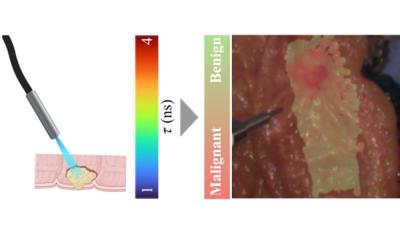Procedure update
Endoscopy in Lithuania
By our correspondent Andrius Vagoras
The well-known Whipple procedure, or pancreaticduodenectomy, recently underwent a transformation due to the skills of Nerijus Kaselis MD, Head of Abdominal and Endoscopic Surgery at Klaipeda District Hospital.

For he performed, for the first time in Eastern Europe, a laparoscopic procedure on a female patient with cancer of the major duodenal papilla. During this, part of her pancreas, duodenum, the small loop of the intestine, gallbladder and ducts were removed, and anastomoses carried out via small openings in abdominal wall. The advantages of the procedure include conserving the stomach, part of which must be removed in the Whipple procedure. Even if performed in the traditional way, the procedure is one of the trickiest.
The 12-hour time span
‘I felt normal after only two days,’ said Dr Kaselis, speaking of the muscle discomfort in his shoulders and neck due to working for hours with both hands raised and head bent over his patient. Most of the time spent was on the anastomoses. On average, the entire operation takes 12 hours, which is why it is unlikely to become a daily procedure – unless there were several surgeons working - one to remove diseased tissue, the other to carry out anastomoses.
‘Of course,’ Dr Kaselis added, ‘the procedure also couldn’t be daily because only stage I and II tumours can be treated with laparoscopic surgery. For the bigger tumour the only option is classical surgery, through the abdominal wall.’
He is very confident that laparoscopy could be used for early stage tumours. He points out to those who doubt whether a tumour could be removed radically that, when performing a laparoscopic procedure, the surgeon can see an enlarged image of the lymph nodes, so can select and remove more of them than when observing only with the naked eye. This is of great importance when dealing with cancer, he emphasises.
After this surgery, the woman patient was comfortable and could drink within the first day and eat after day two. Peristalsis was quickly restored and there was no gastric arrest. Results from the histological evaluation of the lymph nodes showed the patient would not need chemotherapy. The only advantage of the classical operation is the time-span - usually eight hours, compared with 12 for laparoscopic surgery. But, Dr Kaselis argues, what was important several years ago isn’t today. Modern anaesthesia now has so few time-related complications that the additional four hours are worth it, and benefit the patient after only a day.
‘This procedure was not extraordinary to me,’ he reflected. ‘It is just the next logical step from earlier experience.’ Laparoscopic connections of the abdominal cavity organs are not so difficult, he said, after 14 years in daily practice. In 1993, Dr Kaselis performed his first laparoscopic removal of a gall bladder, just a month after the first was carried out at Vilnius University Hospital. In Lithuania he also pioneered the laparoscopic removal of a gangrenous appendix, intestinal obstruction and laparoscopic closure of a perforated duodenal ulcer. In 1995, the removal of a common biliary duct was the first, not only in his country, but also in East Europe, and a right side colonectomy was among the first couple of dozen - globally.
To his mind, to be successful needs experience as well as innovation, and hospital decisions makers can influence the overall progress. ‘Maybe,’ he said, with a smile, ‘if I was not working in a third-world country hospital, there would be less ambition to one day become the first.’
The secret ingredient: ambidexterity
Dr Kaselis intimates that he has an inborn asset to perform endoscopy. Unlike most people, he is fully ambidextrous. His parents noticed his skills with both hands, but at school his right hand had to be put to use. However, in this type of surgery he is happy to be able to use both hands with equal ability. After introducing the manipulation tubes some movements must be performed with the right hand, some with the left. This naturally strains those with one dominating hand, but he experiences no discomfort, loss of control or slow-down in the work.
Bariatric surgery – the future
Although bariatric surgery in Lithuania and neighbouring countries is only on its infancy, Dr Kaselis has performed over 70 of these procedures in the last two years, and he recalls, with professional joy, that those obese patients always remember the person who helped them.
He is also increasingly convinced that patients should be offered bypass surgery instead of adjustable gastric lap-band surgery. Bypass surgery is trickier for a surgeon, but far more effective and with lower rates of complications for the patient, he says, and only three surgeons in Lithuania can perform this type of surgery
Dr Kaselis expressed surprise at the short-sightedness of politicians and the poor public understanding of how much bariatric surgery could help the obese. Whilst politicians in other countries discuss which type of surgery for the obese should be reimbursed from state insurance, Lithuania sees obesity not as a medical concern, but as a consequence of life style, so there is no reimbursement. Yet, studies indicate that 62 thousand obese people in Lithuania are candidates for bariatrics surgery!
He would recommend bariatric surgery to treat anyone with a body mass index over 40 and, of course, with a history of unsuccessful previous treatment by dietician and endocrinologist.
The average weight reduction after bypass bariatric surgery is over 70%, he pointed out - enough to cure more than 80% of obesity-related diabetes, hypertension, hyperlipidemia, impotence, snoring, and dramatically reduce the intake of medications.
For more information, visit http://www.gastroklinika.lt/nerijus-kaselis/
08.07.2007





